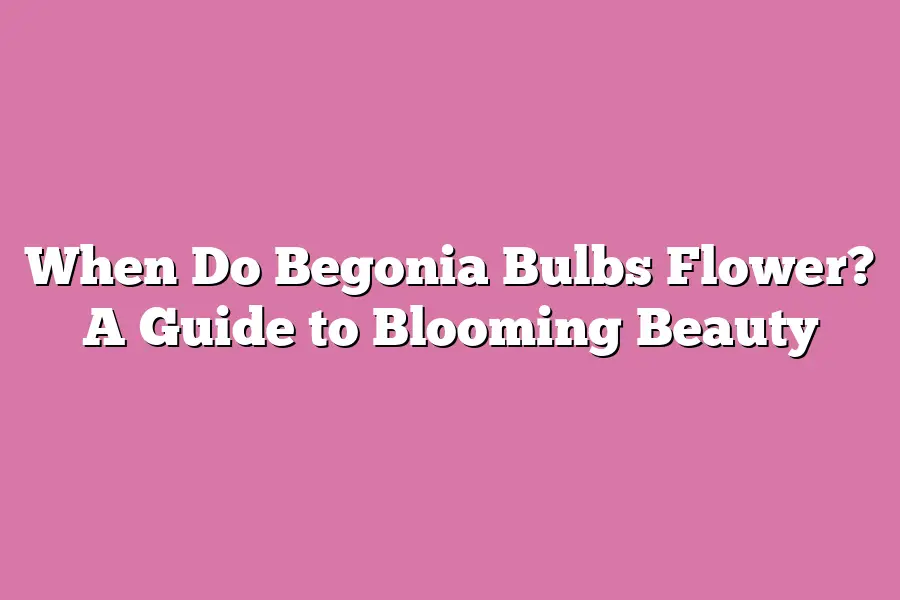Begonia bulbs typically bloom in late spring to early summer, around 12-16 weeks after planting. The exact flowering period may vary depending on factors like climate, soil quality, and specific begonia species. In general, begonias produce beautiful flowers from May to July, with some varieties blooming earlier or later than others.
As a begonia enthusiast, I’ve always been fascinated by the intricate dance between light, temperature, and water that ultimately leads to those stunning blooms.
There’s something truly magical about witnessing a begonia bulb burst forth with vibrant flowers, as if the very essence of beauty has been distilled into its delicate petals.
But let’s be real – achieving this blooming beauty isn’t always a straightforward process.
As someone who’s spent countless hours studying the intricacies of these lovely plants, I’ve come to realize that there are many factors at play when it comes to coaxing those begonias to flower.
In this guide, we’ll delve into the key elements that influence blooming time – from light exposure and temperature fluctuations to watering habits.
We’ll also explore ideal conditions for optimal flowering, as well as troubleshoot common issues that might hinder your plants’ progress.
By the end of this journey, you’ll be equipped with the knowledge and confidence to nurture those begonias into radiant bloomers, filling your home or garden with an explosion of color and joy.
Table of Contents
Factors Affecting Blooming Time
As a begonia enthusiast, you’re probably eager to know when those gorgeous flowers will start blooming.
But did you know that various factors can influence the timing of your begonia’s flowering beauty?
Let’s dive into the top three factors affecting blooming time: light exposure, temperature, and watering habits.
Light Exposure
When it comes to lighting, begonias are a bit like us humans – we all have our preferences!
Some species thrive in bright indirect light, while others prefer low-light conditions.
So, what’s the ideal scenario for your begonia?
- Bright Indirect Light: Begonias like Begonia x hybrida ‘Begonia semperflorens’ love basking in the warm glow of a sunny window or a grow lamp with a gentle intensity (around 1,500-2,000 lux). This encourages robust growth and, eventually, flowering.
- Low-Light Conditions: Some species, like Begonia obtusifolia, are adapted to low-light environments. In this case, providing filtered light (around 100-500 lux) can help promote blooming.
Temperature
Temperature fluctuations also play a significant role in determining when your begonia will bloom.
Cooler temperatures can stimulate flowering in some species, while warmer temperatures might delay it in others.
- Cooler Temperatures: For Begonia x hybrida ‘Begonia semperflorens’, temperatures between 55°F (13°C) and 65°F (18°C) can induce flowering. This is because cooler temperatures can help regulate the plant’s growth rate, allowing for more energy to be directed towards flower production.
- Warmer Temperatures: On the other hand, some begonias like Begonia x hybrida ‘Begonia semperflorens’ respond well to warmer temperatures (around 65°F/18°C to 75°F/24°C). This can promote healthy growth and flowering.
Watering Habits
Consistent moisture is essential for promoting blooming in begonias.
Here are some tips to keep your plants happy:
- Maintain Optimal Watering Schedules: Begonias prefer soil that’s consistently moist but not waterlogged. Aim for a frequency of watering based on the pot size, soil type, and climate.
- Check Soil Moisture: Stick your finger into the soil up to the first knuckle. If it feels dry, it’s time to water. If it’s already damp or wet, wait another day.
By understanding these three factors – light exposure, temperature, and watering habits – you’ll be well on your way to coaxing beautiful blooms from your begonia.
Remember, every species is unique, so observe and adjust accordingly to encourage the best flowering results.
Ideal Conditions for Blooming Beauty
As a begonia enthusiast, you’re probably eager to coax those gorgeous blooms out of your bulbs.
But before we dive into the specifics, let me ask you this: Have you ever stopped to think about what your begonias are actually asking from you?
Are they craving bright lights or warm temperatures?
Maybe they just want a little TLC in the form of consistent watering.
Well, wonder no more!
Today, we’re going to explore the ideal conditions for begonia bulbs to flower.
So, grab your favorite cup of coffee (or tea, if that’s your thing), and let’s get started!
Light Exposure: The Key to Blooming Success
When it comes to lighting, begonias are a bit finicky.
They need indirect light, but not too much – think 12-14 hours of soft, filtered sunlight per day.
Why is this important?
Well, direct sunlight can scorch those delicate leaves and prevent your bulbs from flowering.
So, if you’re placing your begonias near a window, make sure to use a sheer curtain or shade to filter the light.
Some popular begonia species that thrive under these conditions include:
- Begonia x hybrida (the classic hybrid begonia)
- Begonia semperflorens (the annual begonia)
- Begonia obtusifolia (the obtuse-leafed begonia)
Temperature Range: The Sweet Spot
Next up, let’s talk temperature.
Begonias prefer a cozy range of 65F to 75F (18C to 24C).
Why is this important?
Well, temperatures that are too hot or too cold can stress out your bulbs and prevent flowering.
Think of it like Goldilocks – they need a temperature that’s just right.
Some examples of begonia species that enjoy these temperatures include:
- Begonia x corallina (the coral begonia)
- Begonia x tuberhybrida (the tuberous hybrid begonia)
- Begonia obtusifolia var. elliptica (the elliptical-leafed begonia)
Watering Schedule: Consistency is Key
Now, let’s talk watering.
Begonias need consistent moisture with a slight drying between waterings.
Why is this important?
Well, overwatering can cause those bulbs to rot, while underwatering can lead to a lack of flowering.
So, make sure to check the soil daily and only water when it feels dry to the touch.
Some popular begonia species that thrive under these conditions include:
- Begonia x hybrida (the classic hybrid begonia)
- Begonia semperflorens (the annual begonia)
- Begonia obtusifolia (the obtuse-leafed begonia)
In conclusion, when it comes to begonias, ideal conditions for blooming beauty involve providing the right amount of light exposure, temperature range, and watering schedule.
By following these simple tips, you’ll be well on your way to coaxing those gorgeous blooms out of your bulbs.
Happy planting!
Troubleshooting Common Issues: The Secrets to Begonia Bulbs’ Blooming Beauty
As a begonia enthusiast, I’m sure you’re eager to coax those beautiful blooms out of your bulbs.
But let’s face it – things don’t always go as planned.
When do begonia bulbs flower, you ask?
Well, that depends on a few factors.
In this section, we’ll tackle the common issues that might be hindering your begonias’ blooming beauty.
Overwatering and Underwatering: The Dynamic Duo of Doom
You know the drill – too much water, and your begonias are stuck in a soggy rut.
Too little water, and they’re as dry as the Sahara desert.
So, how do you strike that perfect balance?
It’s all about observation and adjustment.
- The Overwatering Solution: Check your soil moisture by sticking your finger into the soil up to the first knuckle. If it feels wet, wait a few days before watering again. If it’s dry, give those begonias a good soaking.
- The Underwatering Solution: Increase your watering frequency, but make sure you’re not overdoing it. Begonias prefer well-draining soil, so if you notice water pooling on the surface, it’s time to repot with some fresh soil.
Lighting Up: When Inadequate Light Exposure is the Problem
Begonias adore bright, indirect light – think east- or west-facing windows or grow lights.
But what happens when your begonias are stuck in a dark corner?
- The Low-Light Solution: Consider moving your begonias to a spot with brighter light or using LED grow lights to supplement their natural light.
- The Solution for Begonias in Shaded Areas: Don’t worry, these beauties can thrive in partial shade. Just be sure to maintain the right temperature (more on that below).
Temperature Tales: When Fluctuations Hinder Blooming
Temperature fluctuations might not be as dramatic as a rollercoaster ride, but they can still cause your begonias to stall.
- The Solution for Temperature Fluctuations: Keep an eye on those thermometers! Most begonias prefer daytime temperatures between 65°F (18°C) and 75°F (24°C). At night, it’s okay to let things cool down a notch – around 55°F (13°C) is fine.
- The Solution for Begonias in Extreme Temps: If you live in an area with extreme temperatures (we’re talking desert hot or Arctic cold), consider using thermal insulation or moving your begonias indoors during the most intense periods.
By addressing these common issues and implementing the solutions above, you’ll be well on your way to coaxing those beautiful blooms out of your begonia bulbs.
Remember – it’s all about finding that sweet spot where your begonias can thrive.
Happy growing!
Final Thoughts
As you’ve learned in this guide, begonia bulbs are a treasure trove of blooming beauty just waiting to be unlocked.
With the right combination of light, temperature, and watering habits, you can coax those gorgeous flowers out of your plants.
Whether you’re a seasoned green thumb or just starting out, understanding the factors that affect blooming time and ideal conditions for flowering will have you enjoying stunning displays in no time.
Don’t let common issues like overwatering or inadequate light get in the way – instead, troubleshoot with confidence using the tips and solutions outlined here.
Remember, every begonia is unique, so be patient, observe, and adjust your approach as needed.
Now that you’ve got this guide under your belt (or should I say, leaf?), go ahead and give those begonias the TLC they deserve.
With a little practice and patience, you’ll be enjoying the fruits of your labor – or rather, the flowers!

